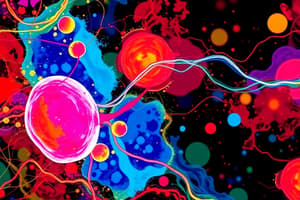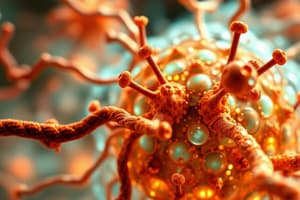Podcast
Questions and Answers
Which type of cell signalling involves hormones being secreted into the bloodstream to act on distant target cells?
Which type of cell signalling involves hormones being secreted into the bloodstream to act on distant target cells?
- Endocrine signalling (correct)
- Juxtacrine signalling
- Autocrine signalling
- Paracrine signalling
A cell releases a signalling molecule that binds to receptors on its own surface. What type of signalling is this?
A cell releases a signalling molecule that binds to receptors on its own surface. What type of signalling is this?
- Endocrine signalling
- Autocrine signalling (correct)
- Paracrine signalling
- Juxtacrine signalling
Which of the following best describes juxtacrine signalling?
Which of the following best describes juxtacrine signalling?
- Signalling through direct contact between cells (correct)
- Signalling to the same cell that released the signal
- Signalling through the bloodstream
- Signalling to nearby cells without direct contact
What is a key characteristic of signalling molecules that bind to intracellular receptors?
What is a key characteristic of signalling molecules that bind to intracellular receptors?
How do intracellular receptors primarily function once bound to their ligand?
How do intracellular receptors primarily function once bound to their ligand?
What is the role of G proteins in cell signalling pathways involving G protein-coupled receptors (GPCRs)?
What is the role of G proteins in cell signalling pathways involving G protein-coupled receptors (GPCRs)?
What enzymatic activity is characteristic of receptor tyrosine kinases (RTKs)?
What enzymatic activity is characteristic of receptor tyrosine kinases (RTKs)?
How do ligand-gated ion channels contribute to cell signalling?
How do ligand-gated ion channels contribute to cell signalling?
What is the primary function of second messengers in cell signalling?
What is the primary function of second messengers in cell signalling?
Which of the following is a common mechanism for regulating signalling pathways?
Which of the following is a common mechanism for regulating signalling pathways?
What is the role of phosphatases in regulating cell signalling pathways?
What is the role of phosphatases in regulating cell signalling pathways?
How do GTPase activating proteins (GAPs) regulate G protein activity?
How do GTPase activating proteins (GAPs) regulate G protein activity?
What role do feedback loops play in cell signalling?
What role do feedback loops play in cell signalling?
Which of the following cellular processes is NOT directly regulated by cell signalling?
Which of the following cellular processes is NOT directly regulated by cell signalling?
Defects in signalling pathways can lead to which of the following diseases?
Defects in signalling pathways can lead to which of the following diseases?
Which of the following is NOT a common second messenger in cell signalling?
Which of the following is NOT a common second messenger in cell signalling?
What is the general outcome of the MAP kinase pathway?
What is the general outcome of the MAP kinase pathway?
How does the PI3K/Akt pathway primarily contribute to cell survival?
How does the PI3K/Akt pathway primarily contribute to cell survival?
What is the primary role of the JAK/STAT pathway in cell signalling?
What is the primary role of the JAK/STAT pathway in cell signalling?
Which of the following best describes the relationship between kinases and phosphatases in cell signalling?
Which of the following best describes the relationship between kinases and phosphatases in cell signalling?
Flashcards
Signalling
Signalling
The process by which cells communicate to coordinate functions, involving the transmission of information from one cell to another.
Endocrine signalling
Endocrine signalling
Signalling molecules (hormones) are secreted into the bloodstream and act on distant target cells throughout the body.
Paracrine signalling
Paracrine signalling
Signalling molecules act on nearby target cells.
Autocrine signalling
Autocrine signalling
Signup and view all the flashcards
Juxtacrine signalling
Juxtacrine signalling
Signup and view all the flashcards
Receptors
Receptors
Signup and view all the flashcards
Cell-surface receptors
Cell-surface receptors
Signup and view all the flashcards
Intracellular receptors
Intracellular receptors
Signup and view all the flashcards
G protein-coupled receptors (GPCRs)
G protein-coupled receptors (GPCRs)
Signup and view all the flashcards
Receptor tyrosine kinases (RTKs)
Receptor tyrosine kinases (RTKs)
Signup and view all the flashcards
Ligand-gated ion channels
Ligand-gated ion channels
Signup and view all the flashcards
Signalling pathways
Signalling pathways
Signup and view all the flashcards
Second messengers
Second messengers
Signup and view all the flashcards
Phosphatases
Phosphatases
Signup and view all the flashcards
GTPase activating proteins (GAPs)
GTPase activating proteins (GAPs)
Signup and view all the flashcards
Study Notes
- Signalling coordinates cell function through cell-to-cell communication
- Information transmits from one cell to another, often over a distance, altering the receiving cell's behavior
- Molecular events in signalling pathways create a cascade to amplify signals and trigger cellular responses
Types of Signalling
- Endocrine signalling involves hormones secreted into the bloodstream acting on distant target cells
- Paracrine signalling acts on nearby target cells
- Autocrine signalling involves a cell releasing a signalling molecule that binds to its own receptors, changing its behavior
- Juxtacrine signalling uses direct contact between two cells
Signalling Molecules
- Signalling molecules include diverse substances like proteins, peptides, amino acids, nucleotides, steroids, fatty acids, and dissolved gases
- These molecules initiate a signalling cascade by binding to specific target cell receptors
- Hydrophobic molecules cross the plasma membrane to bind intracellular receptors, while hydrophilic molecules bind to cell-surface receptors
Receptors
- Receptors are proteins initiating cellular responses by binding to signalling molecules
- Cell-surface receptors are transmembrane proteins binding to hydrophilic signalling molecules outside the cell
- Intracellular receptors reside inside the cell, binding hydrophobic signalling molecules that cross the plasma membrane
Cell-Surface Receptors
- G protein-coupled receptors (GPCRs) activate intracellular G proteins to regulate enzymes and ion channels
- Receptor tyrosine kinases (RTKs) possess enzymatic activity, phosphorylating tyrosine residues upon ligand binding
- Ligand-gated ion channels open or close ion channels upon ligand binding, changing the cell's electrical potential through ion flow
Intracellular Receptors
- Intracellular receptors are located in the cytoplasm or nucleus and bind to hydrophobic signalling molecules that can cross the plasma membrane
- Ligand binding causes these receptors to act as transcription factors, regulating specific gene expression
Signalling Pathways
- Signalling pathways are molecular event series that occur post-receptor activation
- Protein modifications, like phosphorylation, often amplify and transmit the signal
- Common pathways: MAP kinase, PI3K/Akt, and JAK/STAT
Second Messengers
- Second messengers are small, intracellular molecules amplifying and spreading the signalling signal
- Common examples include cyclic AMP (cAMP), calcium ions (Ca2+), and inositol trisphosphate (IP3)
Regulation of Signalling
- Signalling pathways are highly regulated, ensuring appropriate response to external stimuli
- Regulation occurs at multiple levels, including receptor expression, protein modification, and feedback loops.
- Phosphatases halt pathways by removing phosphate groups from proteins
- GTPase activating proteins (GAPs) stimulate GTP hydrolysis by G proteins, inactivating them
- Feedback loops can amplify (positive) or dampen (negative) the signalling response
Significance of Signalling
- Signalling is vital for cell communication, development, and homeostasis
- It regulates growth, differentiation, movement, and apoptosis
- Signalling pathway defects can lead to diseases like cancer, diabetes, and neurological disorders
Studying That Suits You
Use AI to generate personalized quizzes and flashcards to suit your learning preferences.




